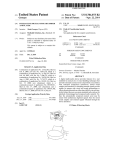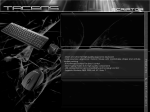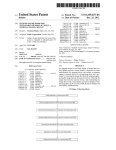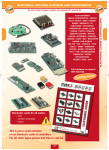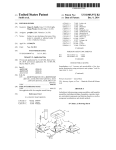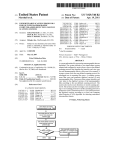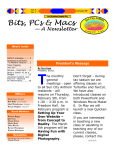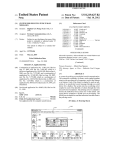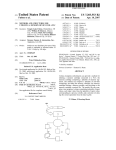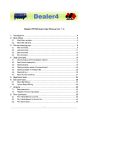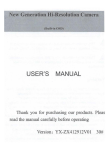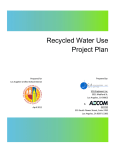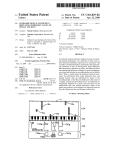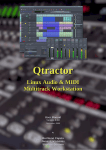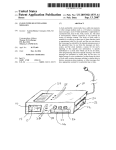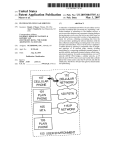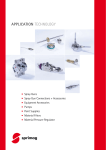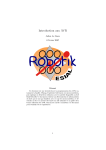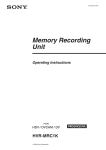Download Dynamically changing music
Transcript
US007078607B2
(12)
(54)
(75)
United States Patent
(10) Patent N0.:
Alferness
(45) Date of Patent:
DYNAMICALLY CHANGING MUSIC
Inventor:
Jul. 18, 2006
6,281,420 B1 *
8/2001
Suzuki et a1. ........... .. 84/477 R
6,281,421 B1 *
8/2001
Kawaguchi
Anton Perry Alferness, Seattle, WA
6,433,266 131*
55/2002 Fay et a1~
(Us)
6,683,241 B1 *
l/2004 Wieder
2001/0039872 A1 *
'
US 7,078,607 B2
.
(73)
Asslgnee' Anton Alferness’ Seattle’ WA (Us)
(*)
Notice:
11/2001
Cliff ........ ..
84/609
84/609
.
.
84/609
2003/0159566 Al*
8/2003
2004/0112202 Al*
6/2004 Smith et a1. ................ .. 84/609
Subject to any disclaimer, the term of this
Sater et a1.
. . 84/603
84/615
OTHER PUBLICATIONS
patent is extended or adjusted under 35
_
U_S_C_ 154(b) by 186 days_
_
Acid User Manual, 1999, Sonic Foundry.*
AmaZon.Com, Acid Music 3.0, Aug. 8, 2001, user revieWs.*
(21) App1_ NO; 10/435,417
VersiontrackerCom, Acid Pro version 4.0, May 10, 2002*
*
(22) Filed:
May 9, 2003
_
(65)
_
_
(74) Attorney, Agent, or FirmiTimothy Sullivan; Merchant
Nov. 13, 2003
& Gould
Related US. Application Data
(57)
(60) grgggéoniloilijgloi?gign 21253251313123
’ M ’ I; 2002
on
(51)
ay
’
pp
19523
'
’
ABSTRACT
The present invention provides dynamically changing musi
’
cal compositions and sound compositions. Provided is a
'
dynamic music sound ?le format, as Well as an illustrative
Int Cl
operating environment in Which the invention may be prac
A 6éH /00
G04B 13/00
52
.
Primary Examinerileifrey W Donels
P1101‘ Publlcatlon Data
Us 2003/0212466 A1
.
“ed by exammer
(2006 01)
(200601)
84/609
time the user listens to a song or sound composition, it may
. ....... ...... ..: .................................... ..
change' For example, the user may listen to a song and then
(58)
Field of Classi?cation Search ................ .. 84/ 609,
play the Same Song again and hear a di?erem Version of the
(56)
See apphcanon ?le for Complete Search hlstory'
R f
Ct d
(
U 5 Cl
ticed. The sound ?le includes many di?cerent characteristics
relating to the components that are easily accessible. Each
)
I. .
'
_
_
_
e erences
84/634
song. A script tool is used to create scripts that are used to
play back a song. The scripts are user de?nable and may, for
example, de?ne a speci?c order to play the components,
de?ne the components that may be played next to each other
during the playback. The possibilities for neW music expe
rience are expanded, adding tremendous value for the lis
1 e
U.S. PATENT DOCUMENTS
i i
2:55)???""""""""
tener and tremendous creative opportunities for the artists.
5,973,255 A * 10/1999 Tanji
6,093,880 A *
84/636
7/2000 Arnalds .................. .. 84/464 R
13 Claims, 7 Drawing Sheets
400
RECORDING STUDIO
i
‘El E
TRACK
I I I
TRACK REPOSITORY
N
COMPONENTS
\>
TooLs
SCRIPTS
/ WORKBOOK
SERVER
ORGANIZATION
MATRIX
CONDITIONS
CLIENT
TENUATOR
PLAYBACK
ENGINE
SCRIPTOR
TooL
U.S. Patent
Jul. 18, 2006
Sheet 1 0f 7
US 7,078,607 B2
120
120
110
ROUTER
FIG. 1
WIDE
AREA
130
NETWORK
(WAN)
1 10
I":
1 10
ROUTE
-
140
120
REMOTE
COMPUTER
120
LOCAL
AREA
NETWORK
(LAN)
140
REMOTE
COMPUTER
100
ROUTER
U.S. Patent
Jul. 18, 2006
Sheet 2 0f 7
g
200
H!
2
/ l I E
/,/’
\ \
llllllllllllll'
/ / /
US 7,078,607 B2
-
‘\\\
/ llllllllllllll\
/ / ’
\ \
COMPUTING DEVICE
\ \
CENTRAL PROCESSING UNIT v12
216
\
/
222
m)
|
220
RAM
OPERATING
l
F.)
CD-ROM/ ,\
DVD-ROM
SYSTEM
VT MUSIC
226
2
\/
DR'VE
NETWORK
,~\/23O
lNTERFACE
PROGRAM
INPUT/OUTPUT
INTERFACE
234
PROGRAMS
210
"\j
UNIT
’\\/224
HARD DISK
DRIvE
232
9
ROM
VIDEO
DISPLAY
BIoS
218
("Q
/\
214
\/
ADAPTER
I
V
V
FIG. 2
228
/\/
U.S. Patent
Jul. 18, 2006
Sheet 3 0f 7
US 7,078,607 B2
300
UsER
/ /
P
DEVICE
‘ \
/
-
\
/ I /
\ \ \
I I /
\ \ \
/
\ \ \
CENTRAL PROCESSING UNIT
310
306
\/
322
318
/ |
312
|
RAM
OPERATING
SYSTEM
/
HARD DISK
DRIVE
WWW BROWSER "\
314
P
|
CD-ROM/
DVD-ROM /\
316
DRIVE
\/
320
302
\,
NETWORK
PROGRAMS
INPUT/OUTPUT‘
334
VT PROGRAM
INTERFACE {_
INTERFACE
UNIT
340
304
SOUND
ROM
CARD /\/
T
326
A
/
BIOS
324
I
VIDEO
308
DISPLAY ’\/
PLAYBACK ’"\/342
ADAPTER
ENG'NE
‘
k
‘V
v
FIG. 3
V
U.S. Patent
Jul. 18, 2006
Sheet 4 0f 7
US 7,078,607 B2
400
RECORDING STUDIO
[___
TRACK TRACK
1
2
TRACK
I
I
I
COMPONENTS
N
|——-— N
TOOLs
II
/ WQRKBOOK
SERVER
ORGANIZATION
MATRIX
CONDITIONS
CLIENT
PLAYBACK
ENGINE
CLIENT
CLIENT
PLAYBACK
ENGINE
TENUATOR
PLAYBACK
ENGINE
SORIPTOR
TOOL
FIG. 4
U.S. Patent
Jul. 18, 2006
Sheet 5 0f 7
Type
Type
Date Created/Modified
Date Created/Modified
Size
Size
Tempo/Time/Play Length
Tempo/Time/Play Length
Pitch/Frequency/Key
Pitch/Frequency/Key
Volume
Volume 2
Stereo/Mono
Stereo/Mono
Class
Class
FX
FX
User Defined
User De?ned
US 7,078,607 B2
Sound File
Markers
FIG. 5
U.S. Patent
Jul. 18, 2006
Sheet 6 0f 7
PREPARE SOUND / 605
TRACKS
STORE TRACKS
/ 610
PROCESS TRACKS / 615
CREATE SCRIPTS / 620
MAKE SCRIPTS
/ 625
AVAILABLE
PLAY THROUGH
PLAYBACK ENGINE
FIG. 6
/__ 630
US 7,078,607 B2
U.S. Patent
Jul. 18, 2006
US 7,078,607 B2
Sheet 7 0f 7
ORGANIZE
COMPONENTS
705
l
ANALYzE AND
ADJUST
COMPONENTS
i
DETERMINE
710
715
COMPONENTS FOR
MUSIC
7
‘I,
SET CONDITIONS
720
l
STORE SCRIPTS
FIG. 7
725
US 7,078,607 B2
1
2
DYNAMICALLY CHANGING MUSIC
BRIEF DESCRIPTION OF THE DRAWINGS
CROSS REFERENCE TO RELATED
APPLICATIONS
FIGS. 143 shoW components of an exemplary environ
ment in Which the invention may be practiced;
FIG. 4 illustrates a block diagram of a dynamically
changing music system;
This application claims the bene?t of US. Provisional
Application Serial Nos. 60/379,212, and 60/379,047 ?led
May 9, 2002, the bene?t of the earlier ?ling date of Which
is hereby claimed under 35 USC §ll9 (e).
FIG. 5 illustrates an exemplary sound ?le format;
FIG. 6 illustrates a process How for creating and playing
dynamically changing music; and
FIG. 7 shoWs a process for creating scripts, in accordance
With aspects of the invention.
FIELD OF THE INVENTION
This application relates generally to music playback soft
Ware, and, more speci?cally, to dynamically changing music
and sound compositions.
DETAILED DESCRIPTION
In the folloWing detailed description of exemplary
embodiments of the invention, reference is made to the
BACKGROUND
Recorded music is a dynamic art form, froZen in a static
format. Unlike static art forms like painting or sculpture, the
accompanied draWings, Which form a part hereof, and Which
are shoWn by Way of illustration, speci?c exemplary
embodiments of Which the invention may be practiced.
20
experience of listening to live music is dynamic.
enable those skilled in the art to practice the invention, and
it is to be understood that other embodiments may be
If you Were to folloW an artist on tour, you Would hear the
same songs each night, arranged and performed With impor
tant, vital differences. You might also hear different solos,
different vocal stylings, perhaps different guest musicians, as
utiliZed, and other changes may be made, Without departing
from the spirit or scope of the present invention. The
25
Well as different energy every night.
folloWing detailed description is, therefore, not to be taken
in a limiting sense.
The live music experience is only approximated in the
The present invention is directed at providing dynami
cally changing music. A dynamic music sound ?le format is
static formats of vinyl or CD or MP3. Current technology on
the consumer end does not alloW variation, While nearly
every other form of media has become interactive, involving
These embodiments are described in sufficient detail to
presented, as Well as an illustrative operating environment in
30
the audience to participate and customiZe their oWn expe
Which the invention may be practiced. The scope of the
invention also includes sound as de?ned by anything
rience. VHS has become DVD. Phones have become PDAs.
audible, including narrative Works, musical compositions
TV has become digital content on demand. But What’s
become of music? Only better Ways to compress data.
that include sound or sound elements, or sound accompa
niment in the context of a visual body of Work such as ?lm
Recorded music does not capture the dynamic spirit of the
music. What is needed is a Way to capture this dynamic spirit
on recorded media, so that each experience of listening to a
recorded piece of music can offer something neW.
SUMMARY
35 or video.
FIG. 4 illustrates a block diagram of a dynamically
changing music system M3 or Multi-Mix Matrix, in accor
dance With aspects of the invention. As illustrated in the
40
The present invention is directed at enabling dynamically
changing music compositions or dynamically changing
sound compositions.
According to one aspect of the invention, a dynamic
music sound ?le format is presented. The sound ?le includes
many different characteristics relating to the components
that are easily accessible.
According to another aspect, each time the user listens to
45
a song it may change. For example, the user may listen to a
song and then play the same song again and hear a different
version of the song. There may be a Whole neW verse they’ve
never heard before. Or there’s a piano solo Where there Was
50
parts such as drums and bass, based on song structure and
intent of the artist or sound engineer. Characteristics of these
component parts Will be programmed into the ?le struc
60
tureipitch, tempo, chord structure, and so oniso that the
playback engine can be programmed to make intelligent
tool is used to create scripts that are used to play back a song.
The scripts are user de?nable and may, for example, de?ne
expanded, adding tremendous value for the listener and
tremendous creative opportunities for the artists.
Sound elements of each song may be isolated such as
vocals, guitar, bass, drums, keyboards, etc. or composites of
tions on the drums. Or there is a subtle melody variation in
the main vocals.
a speci?c order to play the components, de?ne the compo
nents that may be played next to each other during the
playback. The possibilities for neW music experience are
Multi-Mix Matrix 400 is a neW mode of recording and
playing back music information in a Way that alloWs vari
ability in an art form (the art form of recorded music) that
has alWays been static. M3 is music that can constantly
evolve. M3 enables music to be separated into its core
components, coded, and built into a matrix that alloWs
variability and interoperability among those components.
55
capela. Many of the differences betWeen versions may in
fact be subtle. For example, slight timing changes or varia
According to yet another aspect of the invention, a script
from the spirit or scope of the invention.
M3 is the neW dimension of music technology by Which
an artist can create dynamic bodies of Work that expand
instead of remaining froZen in a singular representation.
a guitar previously. Or there’s a tWelve-piece string
ensemble and no rhythm track. Or the chorus is suddenly a
?gure, dynamically changing music system 400 includes a
recording studio, tracks, a Workbook, a server, clients, and
playback engine. Not all the components may be required to
practice the invention, and variations in the arrangement and
type of the components may be made Without departing
choices based on music theory. These sound elements are
stored Within a sound ?le that may be accessed and manipu
65
lated (See FIG. 5 and related discussion). Variability is built
into the music architecture, alloWing endless possibilities for
creativity, originality, and innovation, as Well as responsive
neW experiences for the listener.
US 7,078,607 B2
4
3
M3 may provide many advantages to the recording indus
The scriptor may receive sound tracks from many differ
try, including combating piracy; preserving capital; creating
ent locations. The sound tracks may come from a sound
new revenue streams; and evolving the recorded music art
track repository, directly from the recording studio, or some
other source. The scriptor controls the playback engine’s use
form;
of sound ?les (components) and controls use of modi?ca
Multi-Mix Matrix is a bridge between the two industries:
Music and Software. By building the music into software
tion/attenuation tools controlled by playback engine.
architecture, many software protection schemes against
designed to include copy protection against unauthoriZed
For example, the user may create scripts that determine
the dynamic version of a song or sound composition. The
user may set up a script that places a guitar solo within a
song based on marker positions set within the song. The
guitar solos may be chosen based on a wide variety of
characteristics. For example, the solo may be selected based
on the class of the solo (example: JaZZ solo).
Attenuation tools may be used to modify an entire sound
playback.
?le or a portion of a sound ?le when identi?ed for a use in
piracy may be used to protect the music from piracy.
According to one embodiment of the invention, the server
may maintain control over the music never allowing the
client to fully download all the data to play a song, but rather
combine all the data from two locations at the point of
playback. Additionally, the playback engine may be
The potential for new revenue streams for old music
content is enabled. Imagine if you could by an M3 version
of you favorite album from 20 years ago, remixed with
added material. Using M3 a user of the M3 system could
take the studio outtakes from a Miles Davis session and
20
remix them enabling those tracks to become interoperable,
so that every time you played your M3 Miles release, you
heard a different solo on My Funny Valentine.
There is a massive archive of material that is coveted by
music lovers that can be rejuvenated using Multi-Mix
Matrix and released again to the amaZement and joy of fans
25
everywhere.
M3 is a paradigm shift. Artists are able to create works
that change according to preset variables, or respond to the
listener’s taste, or even correspond to the time of day. Any
number of factors determining when and how to change the
in context of a song construct, and further analysis of any
additional or variable sound ?les that could be additionally
built into another mix version of that song. This analysis is
based on musical and organiZational characteristics of the
sound ?les within the context of a song construct for the
purposes of multiple mix outcomes.
Existing multi-track environments or portions of existing
30
environments may be imported into or connected to the
scriptor and playback engine. Some of the multi-track envi
ronments the scriptor is directed at importing or connecting
to include ProTools, Sonic Foundry, Cubase, and the like.
content of the music within the context of the artist’s
controlled allowances, would become possible.
According to one embodiment, the sound elements are
a composition and further identi?ed as having need of
modi?cation. Reasons for modi?cation could include timing
or tempo errors, frequency or key variance, and arrangement
or continuity alignment. These attenuation tools may attenu
ate a given sound ?le or multiple sound ?les at the point of
playback or prior to playback.
The playback engine makes an analysis of the sound ?les
The scriptor tool allows the user to con?gure the com
35
stored in the scripts section of the workbook. The workbook
positions that may be played in the playback engine. The
user may set many attributes within a sound ?le to allow the
is the software platform used to build, control, and playback
playback engine to be able to play and manipulate the sound
a song or a musical or sonic body of work. The scripts
?les.
section allows different modes of music to become inter
changeable. Now, instead of a user being able to store 1,000
songs on their hard drive, they may have 100,000 interop
erable units of sound. Being able to combine sound tracks in
many different ways allows the number of variations of
songs to increase. For example, the same guitar riff may be
able to be included in many different songs. Additionally,
one song may have 20 different guitar solos.
M3 allows proli?c artists to release new versions of songs,
much like companies release new versions of software.
Consumers may buy upgrades of their favorite musical
releases. The artist and record label will pro?t from addi
tional sales to the same people who bought the original
release, and fans would get to experience that artist in a
40
linear scale a user may set when a track may play. Volume
may be adjusted. Various volumes may be used within the
same track.
45
50
parameters, dynamics, such as (EQ, Compressor, gate, and
the like) may be set either through pre playback or by
connecting to signal processors during the execution of
playback. A con?gurable input parameter may also be used.
an instrument de?nition.
Based on the analysis of the class system, playback
scheme (intent, style) and frequency analysis the appropriate
55
parameters may be set to produce a complete song.
Volumes of the sound ?les react to each other and
self-modify their volume levels. Frequency analysis of the
60
when to play them, how to play them; essentially to generate
rules regarding who, what, when and where. The playback
engine is able to recogniZe sound ?les that are compatible
with each other based on the information programmed into
each of the sound ?les, regarding the nature of the content
of the sound ?les.
Whether the audio is mono/ stereo may be adjusted. The
position of the sound relative to some known position within
the ?eld of stereo (pan). Other parameters, such as FX
A user input ?eld may indicate the class of the sound ?le, or
whole new way.
The workbook is used by users, such as sound engineers,
producers, and artists as the interface to create scripts that
direct a playback engine that executes the dynamic music or
sound compositions. The workbook encompasses a unit of
music, for example a song, but may contain multiple pages.
Each so-called page represents and controls a version of the
song or the composition embodied in the workbook. The
scriptor tool allows the selection of which sound ?les to use,
The user may set what tracks or ?les may be used. When,
and what parts of tracks may be used. For example, on a
tracks may be used to adjust the volume levels. Many off the
shelf tools may be used to perform the frequency analysis.
For example, if there are three sound ?les that have low
frequencies, their volume adjustments are then directed by
the intent of the song and one or more of the three sound ?les
will be adjusted lower in accordance with the hierarchy of
song structure or intent
65
The volume matrix may also be used to smooth out areas
of misalignment and inconsistent arrangement structure. For
example, if a new guitar solo sound ?le which is 18 seconds
US 7,078,607 B2
5
6
in length is introduced into a song construct and that allows
for a 14 second solo, volume Will be attenuated either on the
front end or the back end of the introduced guitar solo to ?t
in the structure. Another example might be to interpret a
multiplicity of volume dynamics subtly on an overall set of
includes the other includes the FX type. The sound ?le is
encoded to be modi?able, malleable, and effected by a
playback engine.
Sound ?les may be compared to other sound ?les of the
same type and discern integration possibilities and modi?
cation requirements based on sound ?le attributes. An off the
shelf tool, or a custom tool, may be used for the comparison.
Sound ?les are con?gured to Work With multi-track volume
control matrix.
FIG. 6 illustrates a process How for creating and playing
mix options.
The music recording process (in studio) has alWays been
based on a simple concept: isolation. Each instrument is
recorded on an individual track, so that factors such as
volume, tone, and effect can be adjusted Without altering
other musical elements. The sound engineer gets every
instrument or vocal recording set just right, and then mixes
dynamically changing music, in accordance With aspects of
the invention.
After a start block, the process ?oWs to block 605, Where
the sound tracks are prepared. The sound tracks may be
all the tracks doWn to a stereo pair.
With M3, many old studio sessions can be remastered to
alloW for variation, because most master recordings are
made up of isolated parts. In addition, neW recording ses
sions can increase their scope due to the multiplicity of
outcomes being enabled by the M3 platform. Artists Will
knoW they do not have to reduce their options, they Will have
prepared in a recording studio and processed using many of
the available music programs, including, but not limited too:
ProTools, Sonic Foundry, and Cubase. Moving to block 610,
the tracks are stored in a repository. According to one
embodiment of the invention, the tracks are stored on a
20
the opportunity to explore their options.
The music architecture makes it possible to convert back
catalog recordings into neW releases With added value. By
incorporating alternate takes and different instrumentations,
track so that it has the sound they are looking for. For
example, the user may process the track so that it Will play
in a particular style of music, such as JaZZ, or Rock. A
program may automatically select tracks for a script based
on characteristics of the track. For example, the program
record labels can re-release old favorites to an established,
adoring fan base that already purchases box sets With no neW
content included.
Sound File
FIG. 5 illustrates an exemplary sound ?le format, accord
ing to one embodiment of the invention. The sound ?le for
server that is coupled to the recording studio and the
Workbook environment. Transitioning to block 615, the
tracks are processed. Processing tracks may be performed
manually or automatically. A user may manually modify a
may look for certain tempos, frequencies, and the like, and
30
select and process the tracks based on the selected charac
teristics. FloWing to block 620, the scripts are created. The
scripts de?ne hoW the sound tracks are organized and played
the dynamically changing music system includes many
different ?elds and components. As shoWn in the ?gure, the
sound ?le includes the type of sound ?le; the date created/
together. The process then transitions to block 625, Where
the scripts are made available to the playback device. The
last modi?ed; the siZe; the time play length/rhythmic; the
pitch/frequency/key; the volume; the stereo/mono charac
teristics; the class (instrument, intent) of the sound ?le; the
they may be delivered to the user of the device through
another medium, such as by a CD, DVD, and the like. Once
scripts may be stored on a server accessible by the device or
the user has the scripts and access to the associated sound
markers and marker types; the FX-type-class, and a user
de?ned ?eld(s). The sound ?le format includes the param
eters to combine and modify various sound components to
?les, the user may play the music through the playback
40
create the dynamically changing composition. Markers may
be used Within the ?le to associate certain portions of the
sound ?le With various parameters. For example, one com
ponent of the sound ?le may have one volume, While another
portion of the sound ?le has a different volume. The markers
source should the user desire to purchase the neW content.
The process then moves to an end block and returns to
alloW the sound ?les to contain more than one set of
processing other actions.
parameters.
The sound ?les may be stored many different Ways and on
many different formats. The sound ?le parameters may be
accessed in many different Ways quickly and ef?ciently. For
example, a code, such as a bar code, may store the various
parameters associated With the sound ?le. Other identi?ers
50
playback engine a fast and accurate method of understand
ing the musical or sonic make-up of the ?les.
Sound ?les may be stored many different Ways. Sound
?les may be encoded and compressed. For example, the
55
song may be organiZed together. The process then moves to
block 710 Where the components are analyZed and adjusted.
The components may be analyZed to determine if the
components Will sound correct When played one after
another. For example, the frequencies, volumes, tempo, and
60
sound ?le may be compressed at a 12 or 16 bit sample rate.
The sound ?le is read by a playback engine that may decode
the compressed sound ?le. For example, the sound ?le may
be decoded to 24 bit.
According to another embodiment, the sound ?le may be
encoded into different ?les. For example, the audio portion
of the sound ?le may be the audio, Where another ?le
FIG. 7 shoWs a process for creating scripts, in accordance
With aspects of the invention. After a start block, the process
?oWs to block 705, Where the components are organiZed.
According to one embodiment of the invention, the compo
nents are organiZed based on the characteristics of the
component. For example, all guitar tracks for a particular
may also be used, including: integers; shapes-geometry
(tone) HeightIfrequency; colors (frequency); linear or cir
cular/radial, and the like. All With the purpose of giving the
engine on the device. Each time the user plays the same
music title, they may hear a different version of the tune.
According to one embodiment of the invention, the number
of different versions may be limited from the entire set of
versions available, thereby creating an additional revenue
65
the like may be analyZed. Transitioning to block 715, the
components that form the dynamically changing music Will
be selected. A user creating the script may determine that
they Want to include three different drum tracks, ?ve differ
ent bass tracks, tWo different solos, and the like, that may be
played in different versions of the song. Once the compo
nents have been determined, the user may set the conditions
determining When the components should play together. The
conditions may specify that the components are selected
US 7,078,607 B2
7
8
randomly, or according to a preset routine. Once the scripts
are created, the scripts are stored for later use by the
playback engine. According to one embodiment of the
invention, the scripts are stored in a Workbook containing all
of the sound components used in the creation of the dynami
cally changing song. The process then moves to an end block
and returns to processing other actions.
signal. By Way of example, communication media includes
Wired media such as tWisted pair, coaxial cable, ?ber optics,
Wave guides, and other Wired media and Wireless media such
as acoustic, RF, infrared, and other Wireless media.
The Internet has recently seen explosive groWth by virtue
of its ability to link computers located throughout the World.
As the Internet has groWn, so has the WWW. Generally, the
WWW is the total set of interlinked hypertext documents
Illustrative Operating Environment
FIGS. 1*3 shoW components of an exemplary environ
ment in Which the invention may be practiced. Not all the
residing on HTTP (hypertext transport protocol) servers
components may be required to practice the invention, and
variations in the arrangement and type of the components
Web pages, are typically Written in HTML (Hypertext
Markup Language) or some other markup language, iden
around the World. Documents on the WWW, called pages or
ti?ed by URLs (Uniform Resource Locators) that specify the
may be made Without departing from the spirit or scope of
the invention.
FIG. 1 shoWs a plurality of local area netWorks (“LANs”)
120 and Wide area netWork (“WAN”) 130 interconnected by
particular machine and pathname by Which a ?le can be
accessed, and transmitted from server to end user using
HTTP. Codes, called tags, embedded in an HTML document
routers 110. Routers 110 are intermediary devices on a
associate particular Words and images in the document With
communications netWork that expedite message delivery.
URLs so that a user can access another ?le, Which may
On a single netWork linking many computers through a
mesh of possible connections, a router receives transmitted
messages and forwards them to their correct destinations
literally be halfWay around the World, at the press of a key
20
or the click of a mouse. These ?les may contain text (in a
variety of fonts and styles), graphics images, movie ?les,
media clips, and sounds as Well as Java applets, ActiveX
controls, or other embedded softWare programs that execute
over available routes. On an interconnected set of LANsi
including those based on differing architectures and proto
colsi, a router acts as a link betWeen LANs, enabling 25 When the user activates them. A user visiting a Web page
also may be able to doWnload ?les from an FTP site and send
messages to be sent from one to another. Communication
messages to other users via email by using links on the Web
page.
links Within LANs typically include tWisted pair, ?ber
optics, or coaxial cable, While communication links betWeen
netWorks may utiliZe analog telephone lines, full or frac
tional dedicated digital lines including T1, T2, T3, and T4,
Integrated Services Digital NetWorks (ISDNs), Digital Sub
A server may provide a WWW site. A server is a com
30
puting device connected to the Internet having storage
facilities for storing hypertext documents for a WWW site
scriber Lines (DSLs), Wireless links, or other communica
and running administrative softWare for handling requests
tions links knoWn to those skilled in the art. Furthermore,
computers, such as remote computer 140, and other related
electronic devices can be remotely connected to either LANs
120 or WAN 130 via a modem and temporary telephone link.
The number of WANs, LANs, and routers in FIG. 1 may be
increased or decreased arbitrarily Without departing from the
spirit or scope of this invention.
As such, it Will be appreciated that the Internet itself may
be formed from a vast number of such interconnected
for the stored hypertext documents. A hypertext document
normally includes a number of hyperlinks, i.e., highlighted
portions of text Which link the document to another hyper
netWorks, computers, and routers. Generally, the term
“Intemet” refers to the WorldWide collection of netWorks,
gateWays, routers, and computers that use the Transmission
Control Protocol/Internet Protocol (“TCP/IP”) suite of pro
35
text document possibly stored at a WWW site elseWhere on
the Internet. Each hyperlink is associated With a URL that
provides the location of the linked document on a server
40
45
connected to the Internet and describes the document. Thus,
Whenever a hypertext document is retrieved from any
WWW server, the document is considered to be retrieved
from the WWW. As is knoWn to those skilled in the art, a
WWW server may also include facilities for storing and
transmitting application programs, such as application pro
grams Written in the JAVA programming language from Sun
tocols to communicate With one another. At the heart of the
Internet is a backbone of high-speed data communication
Microsystems, for execution on a remote computer. Like
Wise, a WWW server may also include facilities for execut
lines betWeen major nodes or host computers, including
thousands of commercial, government, educational and
ing scripts and other application programs on the WWW
server itself.
other computer systems, that route data and messages. An
embodiment of the invention may be practiced over the
Internet Without departing from the spirit or scope of the
invention.
The media used to transmit information in communication
50
links as described above illustrates one type of computer
55
A user may retrieve hypertext documents from the WWW
via a WWW broWser application program located on a Wired
or Wireless device. A WWW broWser, such as Netscape’s
NAVIGATOR® or Microsoft’s INTERNET EXPLORER®,
is a softWare application program for providing a graphical
readable media, namely communication media. Generally,
user interface to the WWW. Upon request from the user via
the WWW broWser, the WWW broWser accesses and
computer-readable media includes any media that can be
retrieves the desired hypertext document from the appropri
accessed by a computing device. Computer-readable media
may include computer storage media, communication
ate WWW server using the URL for the document and
HTTP. HTTP is a higher-level protocol than TCP/IP and is
media, or any combination thereof.
60
readable instructions, data structures, program modules, or
requesting broWser or client. The WWW broWser may also
retrieve application programs from the WWW server, such
other data in a modulated data signal such as a carrier Wave
or other transport mechanism and includes any information
delivery media. The term “modulated data signal” means a
signal that has one or more of its characteristics set or
changed in such a manner as to encode information in the
designed speci?cally for the requirements of the WWW.
HTTP is used to carry requests from a broWser to a Web
server and to transport pages from Web servers back to the
Communication media typically embodies computer
65
as JAVA applets, for execution on a client computer.
FIG. 2 shoWs an exemplary computing device that may
operate to perform aspects of the invention.
US 7,078,607 B2
9
10
FIG. 3 depicts several components of an exemplary user
Computing device 200 may include many more compo
nents than those shown in FIG. 2. However, the components
device 300. User device 300 may include many more
components than those shown in FIG. 3. According to one
embodiment of the invention, user device 300 is a mobile
device that may or may not be coupled to a network.
shown are su?icient to disclose an illustrative environment
for practicing the present invention. As shown in FIG. 2,
computing device 200 is connected to WAN/LAN 100, or
other communications network, via network interface unit
210. The network interface unit 210 includes the necessary
tional components be shown in order to disclose an illus
circuitry for connecting computing device 200 to WAN/
trative embodiment for practicing the present invention. As
LAN 100, and is constructed for use with various commu
network interface unit 210 is a card contained within com
shown in FIG. 3, user device 300 includes network interface
unit 302 for connecting to a LAN or WAN, or for connecting
remotely to a LAN or WAN. Network interface unit 302
puting device 200.
Computing device 200 also includes processing unit 212,
is also constructed for use with various communication
However, it is not necessary that those generally-conven
nication protocols including the TCP/IP protocol. Typically,
includes the necessary circuitry for such a connection, and
protocols including the TCP/IP protocol, the particular net
video display adapter 214, and a mass memory, all con
nected via bus 222. The mass memory generally includes
work con?guration of the LAN or WAN it is connecting to,
and a particular type of coupling medium. Network interface
unit 302 may also be capable of connecting to the Internet
through a point-to-point protocol (“PPP”) connection or a
serial line Internet protocol (“SLIP”) connection as known
random access memory (“RAM”) 216, read-only memory
(“ROM”) 232, and one or more permanent mass storage
devices, such as hard disk drive 228, a tape drive (not
shown), optical drive 226, such as a CD-ROM/DVD-ROM
drive, and/or a ?oppy disk drive (not shown). The mass
memory stores operating system 220 for controlling the
20
to those skilled in the art.
User device 300 also includes BIOS 326, processing unit
operation of computing device 200. This component may
306, video display adapter 308, memory, and playback
comprise a general purpose server operating system, such as
engine 342. The memory generally includes RAM 310,
UNIX, LINUXTM, Microsoft WINDOWS NT®, and the
like. Basic input/output system (“BIOS”) 218 is also pro
vided for controlling the low-level operation of server 200.
ROM 304, and a permanent mass storage device, such as a
25
300. The memory may also include a WWW browser 314,
such as Netscape’s NAVIGATOR® or Microsoft’s INTER
The mass memory as described above illustrates another
type of computer-readable media, namely computer storage
media. Computer storage media may include volatile and
nonvolatile, removable and non-removable media imple
mented in any method or technology for storage of infor
mation, such as computer readable instructions, data struc
tures, program modules or other data. Examples of computer
storage media include RAM, ROM, EEPROM, ?ash
memory or other memory technology, CD-ROM, digital
versatile disks (DVD) or other optical storage, magnetic
cassettes, magnetic tape, magnetic disk storage or other
30
NET EXPLORER® browsers, for accessing the WWW. It
will be appreciated that these components may be stored on
a computer-readable medium and loaded into memory of
user device 300 using a drive mechanism associated with the
35
computer-readable medium, such as a ?oppy disk drive (not
shown), optical drive 316, such as a CD-ROM/DVD-ROM
drive, and/ or hard disk drive 318. Input/output interface 320
may also be provided for receiving input from a mouse,
keyboard, or other input device. The memory, network
interface unit 302, video display adapter 308, and input/
magnetic storage devices, or any other medium which can be
used to store the desired information and which can be
accessed by a computing device.
disk drive. The memory stores operating system 312 and
programs 334 for controlling the operation of user device
40
output interface 320 are all connected to processing unit 306
via bus 322. Other peripherals may also be connected to
processing unit 306 in a similar manner.
The mass memory may also store program code and data
for providing tools relating to playing and creating dynami
Playback engine 342 is con?gured to play the music
cally changing music. More speci?cally, the mass memory
may store applications including music program 230, and
executable instructions which, when executed by computing
components in response to scripts associated with the music.
Playback may be programmed in software or programmed in
hardware. The script may instruct the playback engine to
play a series of components in a variety of different ways.
device 200, import and generate dynamically changing
The playback engine may also be programmed to analyZe
programs 234. VT music program 230 includes computer
45
music. Computing device 200 may include a JAVA virtual
components on its own to determine if different components
machine, an SMTP handler application for transmitting and
receiving email, an HTTP handler application for receiving
and handing HTTP requests, JAVA applets for transmission
within a workbook may be played together.
As will be recogniZed from the discussion, aspects of the
50
invention may be embodied on computing device 200, on
to a WWW browser executing on a client computer, and an
user device 300, or on some combination thereof. For
HTTPS handler application for handling secure connections.
The HTTPS handler application may be used for commu
nication with an external security application to send and
receive sensitive information, such as credit card informa
example, programming steps may be contained in programs
334 and/or programs 234.
55
tion, in a secure fashion.
Computing device 200 also comprises input/output inter
face 224 for communicating with external devices, such as
a mouse, keyboard, scanner, or other input devices not
60
shown in FIG. 2. Likewise, computing device 200 may
further comprise additional mass storage facilities such as
optical drive 226 and hard disk drive 228. Hard disk drive
228 is utiliZed by computing device 200 to store, among
other things, application programs, databases, and program
data used by music program 230. For example, sound ?les,
and databases may be stored.
The various embodiments of the invention may be imple
mented as a sequence of computer implemented steps or
program modules running on a computing system and/or as
interconnected machine logic circuits or circuit modules
65
within the computing system. The implementation is a
matter of choice dependent on the performance requirements
of the computing system implementing the invention. In
light of this disclosure, it will be recognized by one skilled
in the art that the functions and operation of the various
embodiments disclosed may be implemented in software, in
?rmware, in special purpose digital logic, or any combina
tion thereof without deviating from the spirit or scope of the
present invention.
US 7,078,607 B2
11
12
The above speci?cation, examples and data provide a
complete description of the manufacture and use of the
composition of the invention. Many embodiments of the
generating a Workbook that contains the script and the
components used Within a sound composition that
has different versions.
8. The apparatus of claim 7, further comprising using a
netWork interface layer to access the components for the
different versions of the sound composition.
invention can be made Without departing from the spirit or
scope of the invention.
What is claimed is:
1. A method for dynamically changing musical composi
tions and sound compositions, comprising:
9. The apparatus of claim 8, further comprising analyZing
the components to determine hoW to play the components
for the version of the sound composition.
10. A system for dynamically changing music and sound
generating components from tracks that have been
recorded;
storing the components for a sound composition; Wherein
a subset of the components for the sound composition
compositions, comprising:
a server, including:
a processor and a computer-readable medium;
an operating environment stored on the computer
readable medium and executing on the processor;
are used for any particular version of the sound com
position;
using a script to de?ne, control, modify and play a version
of a sound composition; Wherein the script details the
interaction of the components used Within the many
versions of the sound composition; and
generating a Workbook that contains the script and the
components used Within a sound composition that has
different versions.
2. The method of claim 1, further comprising generating
the script that details the interaction of the components used
Within different versions of the sound composition.
3. The method of claim 2, Wherein the components
a netWork interface layer operating under the control of
the operating environment and con?gured to connect
With another device; and
20
dynamic music; Wherein the components are generated
from tracks that have been recorded; and
a client, including:
25
include at least three characteristics that are selected from a
set including: a type of sound ?le; a date created/last
modi?ed; a siZe; a time play length/rhythmic; a pitch/
frequency/key; a volume; a stereo/mono characteristic; a
class; a marker and marker types; a FX-type-class, and a
a memory con?gured to store components associated With
30
user de?ned ?eld.
a processor and a computer-readable medium;
an operating environment stored on the computer
readable medium and executing on the processor;
a netWork interface layer operating under the control of
the operating environment and con?gured to connect
With another device; and
a scripting device operating under the control of the
operating environment and operative to perform
4. The method of claim 1, Wherein storing the components
for a sound composition further comprises storing the com
actions, including:
ponents on a server accessible by clients.
accessing the components from the server;
5. The method of claim 2, further comprising encrypting
the components.
6. The method of claim 1, further comprising dynamically
35
determining the components used Within different ver
sions of a sound composition;
selecting a subset of the components for the sound compo
sition Without receiving interaction from a user; and playing
the sound composition that Was dynamically generated.
7. An apparatus for dynamically changing musical com
40
position;
45
a playback device operating under the control of the
operating environment and operative to perform
11. The system of claim 10, further comprising generating
storing components for different versions of a sound
50
from tracks that have been recorded; Wherein a
subset of the components for the sound composition
set including: a type of sound ?le; a date created/last
composition;
55
user; and
modi?ed; a siZe; a time play length/rhythmic; a pitch/
frequency/key; a volume; a stereo/mono characteristic; a
class; a marker and marker types; a FX-type-class, and a
user de?ned ?eld.
used to play the sound composition a different ver
sion of the sound composition may be played by the
playback engine Without receiving interaction from a
the script that details the interaction of the components used
Within different versions of the sound composition.
12. The system of claim 11, Wherein the components
include at least three characteristics that are selected from a
are used for any particular version of the sound
using a script to play a version of the sound composi
tion; Wherein the script details the interaction of the
components used Within the version of the sound
composition; and Wherein each time the script is
storing the components for different versions of the
sound composition; and
generating a Workbook that contains the script and the
components used Within a sound composition that
has different versions.
actions, including:
composition; Wherein the components are generated
generating conditions indicating What components to
play Within the different versions of the sound com
positions and sound compositions, comprising:
a processor and a computer-readable medium;
an operating environment stored on the computer-read
able medium and executing on the processor; and
organiZing components;
analyZing the components;
60
13. The system of claim 11, further comprising encrypting
the components.














